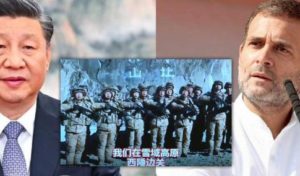
Reacting to a propaganda video that showed China’s flag hoisted in Galwan, former Congress President Rahul Gandhi on Sunday said that in the valley region, only the flag of India looks good.
Taking to his Twitter handle, the 51-year-old leader urged PM Modi to break his silence on the issue, adding that the President Xi Jinping-led country deserved a befitting retort.
“In Galwan, only India’s flag looks good. China need to be given a reply by India, Modi Ji please break your silence,” his tweet in Hindi roughly read.
With a video sent to its stooge Global Times, China shamelessly tried to push its propaganda against India. Under the characters “Never yield an inch of land, “The People’s Liberation Army (PLA) soldiers sent their new year greetings to the Chinese people. “We pledge to the motherland to guard the border,” the soldiers said in the video saluting the national flag as a drone on the snow-capped mountains raised the five-starred red flag in the valley.
The 1988 Consensus, and clash of 2020 at Galwan
In December 1988, Indian Prime Minister Rajiv Gandhi made a historic visit to China, the first such visit by an Indian Prime Minister in 34 years. One of the key decisions that the leaders of the two countries reached back then was that provided the territorial disputes could not be resolved in the near term, Beijing and New Delhi should nonetheless set aside their differences in order to explore growing ties in other areas, of which trade became one of the top prerogatives. It led to a series of agreements, starting with the Border Peace and Tranquility Agreement of 1993, setting in place confidence-building measures (CBMs) and standard operating procedures (SOPs) on the Line of Actual Control (LAC) and a commitment not to change the status quo before the border was settled.
While the two countries continued collaboration in other domains, China began to develop infrastructure along the border, which is also known as the Line of Actual Control, and when India followed the same line and constructed a new road to a high-altitude airbase, it did not go down well with China. Tensions were evident, and ultimately led to the clash on the Sino-Indian border in Ladakh in June last year, the first in the last 45 years. The clash had led to serious injuries on both sides. Almost a year to the clash, while disengagement has taken place at Galwan Valley and the southern and northern banks of Pangong Tso, stand-offs and tensions continue in at least four other locations in Eastern Ladakh – Depsang Plains, Hot Springs and Demchok.




 Driving Naari Programme launched in Chandigarh
Driving Naari Programme launched in Chandigarh






























